In a recent post titled “Stop Exporting Waste, Oppose Polluting Incineration, and Tackle Waste at the Source in Ulster County” KingstonCitizens.org and TownOfUlsterCitizens.org exposed a troubling development: a bipartisan group of Ulster County legislators recently toured ReWorld’s so-called “waste-to-energy” incinerator in Hempstead, Long Island. The plant, formerly owned by Covanta but since acquired by Reworld, takes in more than 2,600 tons of primarily residential trash a day and after incineration produces up to 650 tons of ash, which is then dumped – in part if not all – at the Brookhaven Landfill.
The Brookhaven Landfill sits in the backyard of our friend Monique Fitzgerald—an environmental justice organizer and co-founder of the Brookhaven Landfill Action and Remediation Group (BLARG). Monique lives in North Bellport, a predominantly Black and Latino community with the lowest life expectancy on Long Island and the second-highest asthma rate in Suffolk County. “The Brookhaven Landfill is the site of a major crisis,” Monique says, “polluting the air, land, and water of surrounding communities.”
In a recent letter to The Suffolk Times: “Waste to Energy Argument Doesn’t Hold Up“, she warned: “Labeling incineration as ‘renewable energy’ rewards polluters and harms vulnerable communities…Covanta (Reworld) Hempstead has repeatedly violated environmental standards. DEC’s failure to conduct in-stack monitoring has left critical gaps in understanding the true extent of pollution from this site. The Town of Brookhaven’s $1 million settlement falls far short of remediating the harm done to the community.”
Currently, Ulster County legislators are in talks with Sullivan County about exploring the potential of a ReWorld incinerator in Sullivan County that would require 500,000–900,000 tons of waste per year. Sullivan produces just 120,000; Ulster produces 140,000. They’d need additional counties to partner in order to get their waste tonnage to meet ReWorld’s required threshold for operation. A 20-year commitment would lock both counties into a polluting system, and seriously undermine any credible path toward Zero Waste.
This is not an easy subject, and there are many moving parts around managing Ulster County’s waste. For now, please consider attending tomorrow’s Ulster County Legislature meeting to speak during public comment.
Take action.
The public must act now to shut down any discussions about polluting incineration or so-called “waste-to-energy” projects for our trash in Ulster County, whether proposed in our county or elsewhere. Although these talks are currently happening in committee and not yet on the full county legislature’s agenda, the public can still make its voice heard. Community members are encouraged to show up at legislative meetings and speak during the public comment period on this issue before harmful decisions are made in the background.
WHAT
Provide public comment during Ulster County Legislature meetings
WHERE
Ulster County Legislative Offices located at 244 Fair Street, 6th floor
WHEN
The next one is Tuesday, May 20 at 6:45pm. They meet third Tuesday of each month
HOW
Sign-up to speak after 6:00pm on the 6th floor of the county building. Comments must be no more than 2-minutes in length (approximately 260 words)
TALKING POINTS
To help you further, we’ve created this FACT SHEET with more information.
-
- Manage Waste Locally and Responsibly: Ulster County must take responsibility for its own waste instead of sending it to other communities that bear the environmental and health impacts.
- Say No to Incineration and so-called “Waste-to-Energy”: Incinerators and so-called “waste-to-energy” facilities pollute the air, harm frontline communities, and undermine real solutions to the waste crisis. These private businesses profit by burning more trash – not less – discouraging recycling, composting, and waste reduction.
- Ulster County 2020 Solid Waste Plan: The county’s 2020 Solid Waste Management Plan focused on zero waste strategies and not incineration. That commitment should be upheld, not reversed.
- Support a Zero Waste Implementation Plan: Ulster County Resource Recovery Agency (UCRRA) is working toward a Zero Waste Implementation Plan. They must be supported to finalize this plan and create a public, transparent timeline so residents and legislators can track progress, support efforts, and avoid unexpected policy shifts.
- Support Proven Waste Reduction Strategies: Ulster County should explore successful models like Vermont’s Universal Recycling Law (Act 148), fully implemented by 2020, bans food scraps from landfills, significantly increasing composting efforts and reducing greenhouse gas emissions and implement initiatives such as “pay-as-you-throw” programs. These approaches incentivize waste reduction and help shift us away from a throwaway culture toward more responsible, sustainable behavior.




